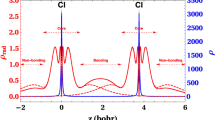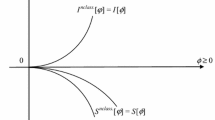Abstract
Covalent bond describes electron pairing in between a pair of atoms and molecules. The space is partitioned in mutually disjoint regions by using a new concept of the electronic drop region R D , atmosphere region R A , and the interface S (Tachibana in J Chem Phys 115:3497–3518, 2001). The covalent bond formation is then characterized by a new concept of the spindle structure. The spindle structure is a geometrical object of a region where principal electronic stress is positive along a line of principal axis of the electronic stress that connects a pair of the R D s of atoms and molecules. A new energy density partitioning scheme is obtained using the Rigged quantum electrodynamics (QED). The spindle structure of the stress tensor of chemical bond has been disclosed in the course of the covalent bond formation. The chemical energy density visualization scheme is applied to demonstrate the spindle structures of chemical bonds in H2, C2H6, C2H4 and C2H2 systems.
Figure Field theory of the energy density.












Similar content being viewed by others
References
Weinberg S (1995) The quantum theory of fields. Cambridge University, Cambridge
Tachibana A (2003) Field energy density in chemical reaction systems. In: Brändas E, Kryachko E (eds) Fundamental perspectives in quantum chemistry: a tribute to the memory of Per-Olov Löwdin, vol 2. Kluwer, Dordrecht, pp 211–239
Tachibana A (2004) Int J Quantum Chem 100:981–993
Tachibana A (2001) J Chem Phys 115:3497–3518
Tachibana A (2002) Energy density in materials and chemical reaction systems. In: Sen KD (ed) Reviews in modern quantum chemistry: a celebration of the contributions of Robert Parr, Chap 45, vol 2. World Scientific, Singapore, pp 1327–1366
Murata M, Ikenaga M, Nakamura K, Tachibana A, Matsumoto K (2001) Phys Status Solidi A 188:579–582
Doi K, Nakamura K, Tachibana A (2001) First-principle theoretical study on reliability of SiO2 thin films under external electric field. In: Ohmi S, Fujita K, Momose HS (eds) Extended abstracts of international workshop on gate insulator 2001. Business Center for Academic Societies Japan, Tokyo, pp 148–151
Egami S, Nakamura K, Tachibana A (2001) First-principle electronic properties of ZrO2 and HfO2 crystals under external electric field. In: Ohmi S, Fujita K, Momose HS (eds) Extended abstracts of international workshop on gate insulator 2001. Business Center for Academic Societies Japan, Tokyo, pp 234–237
Hotta S, Doi K, Nakamura K, Tachibana A (2002) J Chem Phys 117:142–152
Ikenaga M, Nakamura K, Tachibana A, Matsumoto K (2002) J Cryst Growth 237(239):936–941
Yoshida S, Doi K, Nakamura K, Tachibana A (2003) Appl Surf Sci 216:141–148
Hasegawa K, Doi K, Nakamura K, Tachibana A (2003) Mol Phys 101:295–307
Makita T, Doi K, Nakamura K, Tachibana A (2003) J Chem Phys 119:538–546
Makita T, Nakamura K, Tachibana A, Masusaki H, Matsumoto K, Ishihara Y (2003) Jpn J Appl Phys 42:4540–4541
Kawakami Y, Kikura T, Doi K, Nakamura K, Tachibana A (2003) Mater Sci Forum 426(432):2399–2404
Kawakami Y, Higashimaki N, Doi K, Nakamura K, Tachibana A (2003) Phys Status Solidi A 195:3–10
Tachibana A (2002) First-principle theoretical study on the dynamical electronic characteristics of electromigration in the bulk, surface and grain boundary. In: Baker SP (ed) Stress induced phenomena in metallization. American Institute of Physics, New York, pp 105–116
Doi K, Nakamura K, Tachibana A (2003) Appl Surf Sci 216:463–470
Doi K, Iguchi K, Nakamura K, Tachibana A (2003) Phys Rev B 67:115124/1–115124/14
Huntington HB, Grone AR (1961) J Phys Chem Solids 20:76–87
Blech IA, Kinsbron E (1975) Thin Solid Films 25:327–334
Blech IA (1976) J Appl Phys 47:1203–1208
Black JR (1969) IEEE Trans Electron Devices ED 16:338–347
Ho PS, Kwok T (1989) Rep Prog Phys 52:301–348
Thompson CV, Lloyd JR (1993) MRS Bull, pp 19–25
Kawasaki H, Gall M, Jawarani D, Hernandez R, Capasso C (1998) Thin Solid Films 320:45–51
Bosvieux C, Friedel J (1962) J Phys Chem Solids 23:123–136
Kumar P, Sorbello RS (1975) Thin Solid Films 25:25–35
Sorbello RS, Dasgupta BB (1980) Phys Rev B 21:2196–2200
Lodder A (1984) J Phys F Met Phys 14:2943–2953
Lodder A (1989) Solid State Commun 71:259–262
Sorbello RS (1998) Solid State Phys 51:159–231
Lodder A, Dekker JP (1998) The electromigration force in metallic bulk. In: Okabayashi H, Shingubara S, Ho PS (eds) Stress induced phenomena in metallization. American Institute of Physics, New York, pp 315–328
Iguchi K, Tachibana A (2000) Surf Sci 159(160):167–173
Pauli W (1980) General principles of quantum mechanics. Springer, New York
Heitler W (1984) The quantum theory of radiation. Dover, New York
Nakamura K, Doi K, Tachibana A (2004) Molecular regional DFT program package, Version 1. Tachibana Lab, Kyoto University, Kyoto, Japan
Frisch MJ, Trucks GW, Schlegel HB, Scuseria GE, Robb MA, Cheeseman JR, Montgomery JA Jr, Vreven T, Kudin KN, Burant JC, Millam JM, Iyengar SS, Tomasi J, Barone V, Mennucci B, Cossi M, Scalmani G, Rega N, Petersson GA, Nakatsuji H, Hada M, Ehara M, Toyota K, Fukuda R, Hasegawa J, Ishida M, Nakajima T, Honda Y, Kitao O, Nakai H, Klene M, Li X, Knox JE, Hratchian HP, Cross JB, Bakken V, Adamo C, Jaramillo J, Gomperts R, Stratmann RE, Yazyev O, Austin AJ, Cammi R, Pomelli C, Ochterski JW, Ayala PY, Morokuma K, Voth GA, Salvador P, Dannenberg JJ, Zakrzewski VG, Dapprich S, Daniels AD, Strain MC, Farkas O, Malick DK, Rabuck AD, Raghavachari K, Foresman JB, Ortiz JV, Cui Q, Baboul AG, Clifford S, Cioslowski J, Stefanov BB, Liu G, Liashenko A, Piskorz P, Komaromi I, Martin RL, Fox DJ, Keith T, M Al-Laham A, Peng CY, Nanayakkara A, Challacombe M, Gill PMW, Johnson B, Chen W, Wong MW, Gonzalez C, Pople JA (2004) Gaussian 03, Revision B.04. Gaussian Inc., Wallingford, CT, USA
Acknowledgements
This work has been supported in part by Center of Excellence for Research and Education on “Complex Functional Mechanical System” as a COE Program of the Ministry of Education, Culture, Science and Technology of Japan, for which we express our gratitude.
Author information
Authors and Affiliations
Corresponding author
Appendix
Appendix
In the Rigged QED theory, the interaction of a system and its environment is tractable using regional charge and current densities.
Let a system A be embedded in the environment medium M. The corresponding gauge potentials [2] are the regional integrals of the charge and transversal current densities, defined as follows
and
where the subscript A or M of the integral sign denotes the regional integrals confined to the region A or M, respectively.
Since the regions A and M altogether span the whole space, we have
where \(\hat {\vec A}_{{\text{radiation}}} (\vec r)\) denotes that portion of the radiation field.
The electric field \(\hat {\vec E}(\vec r)\) is decomposed into the electric displacement \(\hat {\vec D}(\vec r)\) of the medium M and the polarization \(\hat {\vec P}(\vec r)\) of the system A, defined, respectively, as
so that we have
Likewise, let the magnetic field \(\hat {\vec H}(\vec r)\) of the medium M and the magnetization \(\hat {\vec M}(\vec r)\) of the system A be defined, respectively, as
then we have
The regional charge densities are then represented, respectively, as
and hence
Likewise, the regional current densities are represented as
and hence
The regional decomposition of the longitudinal and transversal components of the current densities are represented as follows
with
where
Using Eqs. 121, 122, 123 and 124, we have the alternative forms of Eqs. 16 and 17, respectively, as
The linear response properties of the system A under the interaction with the environment medium M may formally be represented with obvious notation as follows
Rights and permissions
About this article
Cite this article
Tachibana, A. A new visualization scheme of chemical energy density and bonds in molecules. J Mol Model 11, 301–311 (2005). https://doi.org/10.1007/s00894-005-0260-y
Received:
Accepted:
Published:
Issue Date:
DOI: https://doi.org/10.1007/s00894-005-0260-y




